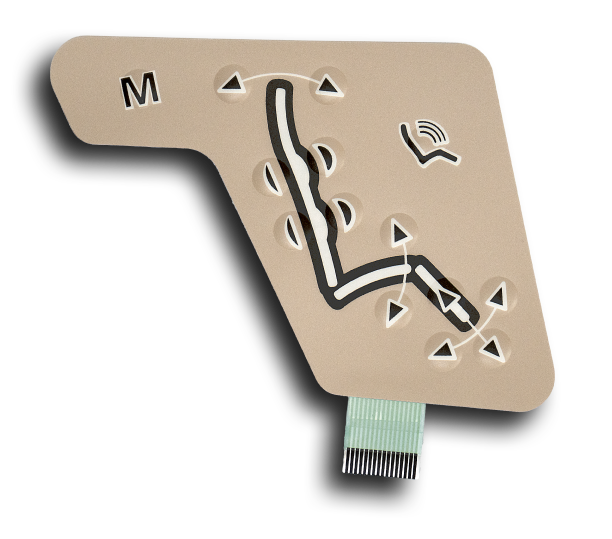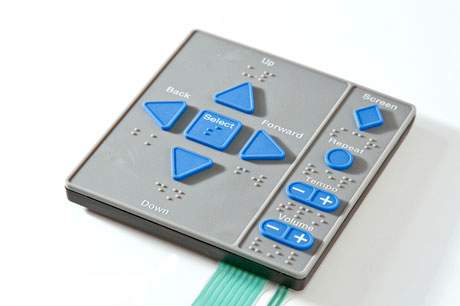How Membrane Switch Technology Functions and Its Duty in Customer User Interface Style
Membrane button innovation is an innovative approach that combines layered products for touch-sensitive input. When pressed, its style is composed of graphic overlays, conductive layers, and glue elements that communicate. This communication not only completes an electrical circuit however also influences the general individual experience. Recognizing the ins and outs of this technology reveals its significant influence on interface design, prompting inquiries about its applications and future developments in different markets.
Understanding Membrane Switch Innovation
Membrane switch innovation acts as a critical element in modern-day interface style. This technology incorporates visuals overlays, touch-sensitive membranes, and circuit layers to produce a small, trustworthy input method for numerous gadgets. The design normally consists of numerous layers, including a printed visuals layer that allows individuals to engage with the device via tactile comments. Membrane buttons are recognized for their longevity, resistance to moisture, and simplicity of cleaning, making them ideal for settings where standard mechanical buttons might fall short. Their inconspicuous layout allows seamless assimilation right into tools, contributing to a smooth appearance. In enhancement, Membrane switches can be customized with different shades, textures, and signs, enhancing customer experience and aesthetic allure. This adaptability makes them preferred in customer electronic devices, clinical tools, and commercial controls, where instinctive interaction is vital. In general, Membrane button innovation represents a substantial advancement in exactly how customers involve with digital interfaces.
Key Components of Membrane Changes
Membrane changes are composed of a number of essential components that add to their functionality and design. The conductive layer products, glue and support layers, and graphic overlay style each play a crucial function in ensuring suitable efficiency and individual interaction. Understanding these elements is essential for effective customer interface layout.
Conductive Layer Products
Conductive layer materials play a crucial duty in the capability and integrity of Membrane buttons. When stress is used to the switch, these materials are responsible for completing electrical circuits. Generally, a combination of conductive inks, such as silver or carbon, is made use of to produce these layers. Silver conductive ink is preferred for its superior conductivity and resilience, while carbon ink is commonly used for affordable applications. The choice of product affects not just the electrical efficiency but also the general life expectancy of the switch. Furthermore, the thickness and structure of conductive layers can influence responsive feedback and switch actuation. Selecting the appropriate conductive product is essential for guaranteeing suitable efficiency in varied individual interface applications.
Glue and Assistance Layers
Sticky and support layers are important components that add to the structural integrity and performance of Membrane buttons. These layers give a durable structure, ensuring that the numerous aspects of the Membrane button remain firmly adhered and appropriately aligned throughout their functional life. The adhesive layer facilitates the attachment of the switch to the underlying surface area, providing longevity against environmental factors such as moisture, temperature variants, and mechanical stress. On the other hand, assistance layers boost the button's strength, avoiding contortion throughout usage and adding to a constant tactile response. Together, these components play a vital role in keeping the efficiency and long life of Membrane switches, ultimately affecting the general customer experience in interface style.
Graphic Overlay Design
Usually neglected, graphic overlay design plays a necessary function in the performance and aesthetics of Membrane switches. This layout mainly offers as the user interface in between the customer and the electronics, providing both aesthetic charm and operational quality. Efficient visuals overlays make use of color, typography, and icons to lead individuals in understanding and maneuvering controls device features. The selection of materials influences durability and tactile comments, making certain the overlay withstands wear while maintaining an enjoyable individual experience. Additionally, specific alignment of the overlay with the underlying components is essential for perfect efficiency. In final thought, thoughtful visuals overlay design improves functionality, contributes to brand identity, and ultimately affects customer contentment in gadgets using Membrane switch modern technology.
The Production Process of Membrane Switches
The production process of Membrane switches includes several important steps that guarantee performance and toughness. Initially, a graphic overlay is developed, including interface aspects and branding. This overlay is published onto a flexible substrate, commonly polyester or polycarbonate, utilizing accuracy printing methods to ascertain clarity and shade accuracy.Next, adhesive layers are applied, followed by the assimilation of conductive traces, frequently made from silver or carbon, which are crucial for electrical connection. These traces are etched or screen-printed onto a different layer. After this, a spacer layer is included in develop the necessary void between the circuit and the overlay layer, enabling tactile comments when activated.Finally, the components are constructed and evaluated for top quality assurance, ensuring that each Membrane switch fulfills the called for requirements for performance and dependability. This meticulous procedure leads to a durable item matched for various applications in customer interface design.
Benefits of Making Use Of Membrane Switches

Membrane switches offer countless benefits that make them a favored option in interface design. One significant advantage is their small and light-weight nature, enabling for structured designs in various applications. In addition, Membrane buttons provide a sealed user interface, safeguarding versus dust, moisture, and pollutants, which enhances durability and reliability. They are also highly personalized, allowing designers to develop unique graphics and designs tailored to particular customer needs.Another advantage is their cost-effectiveness, as they commonly need less material and labor compared to traditional buttons. The tactile feedback of Membrane switches can be crafted to enhance individual experience, using a gratifying action without the mass of mechanical components. Membrane buttons can be quickly integrated into varied atmospheres, such as clinical devices, commercial devices, and customer electronics. On the whole, these advantages emphasize the growing popularity of Membrane switches in modern interface design.
Applications in Various Industries
Extensively used across different sectors, Membrane switch modern technology has found its area in applications ranging from clinical devices to customer electronics. In the medical care industry, these buttons are indispensable to tools such as diagnostic equipment and patient surveillance systems, using resilient, easy-to-clean user interfaces that withstand sanitation processes. The auto industry uses Membrane switches in dashboards and control board, supplying trusted procedure in challenging environments.Consumer electronics, consisting of home devices and video gaming consoles, advantage from the smooth design and customizability of Membrane buttons, boosting customer communication. Additionally, commercial equipment uses these switches for control board, making certain resistance to dust and moisture while preserving functionality.Moreover, the aerospace and armed forces sectors utilize Membrane switches for rugged applications, where reliability and efficiency are crucial. Generally, Membrane button technology offers diverse industries by incorporating performance, durability, and aesthetic allure, making it a versatile choice for modern-day individual interfaces.

Designing User User Interfaces With Membrane Switches
When making interface with Membrane buttons, careful factor to consider of both capability and looks is vital. Membrane changes provide a streamlined, inconspicuous design that can improve aesthetic charm while preserving functionality. Designers need to concentrate on switch format, making sure user-friendly placement for ease of procedure. The responsive comments offered by the Membrane switch is essential; it can impact user satisfaction and total experience.Additionally, shade and graphic aspects should straighten with the brand identification, reinforcing recognition and knowledge. Picking resilient materials that withstand damage is likewise crucial, as long life adds to usability with time. Incorporating backlighting can improve exposure in different lighting conditions, better enhancing individual communication. Ultimately, a properly designed Membrane switch interface balances both type and function, making sure that the customer experience is both effective and appealing, satisfying the demands of varied applications throughout markets.
Future Fads in Membrane Switch Technology
As Membrane button modern technology evolves, the combination of wise functionalities is ending up being significantly popular. These improvements allow improved interactivity and connection within customer interfaces (membrane switch manufacturer). Furthermore, the shift towards environmentally friendly materials reflects an expanding dedication to sustainability in layout methods
Smart Membrane Switches

Eco-Friendly Materials Usage
Among the advancements in Membrane switch innovation, a substantial basics trend is emerging in the direction of using eco-friendly materials. Makers are significantly prioritizing sustainability by integrating naturally degradable plastics and safe inks, decreasing environmental effect. This change not just aligns with international ecological requirements but likewise addresses consumer demand for greener items. Developments in material science have actually made it possible for the growth of durable, eco-friendly alternatives that maintain efficiency without compromising quality. These materials provide comparable capability to conventional options while decreasing waste and toxicity. As markets end up being more eco-conscious, the assimilation of sustainable methods in Membrane button manufacturing is expected to climb, enhancing a commitment to environmental responsibility and leading the means for even more sustainable interface solutions in the future.
Often Asked Questions
Exactly How Do Membrane Switches Differ From Standard Mechanical Buttons?
Membrane switches differ from traditional mechanical buttons largely in building and construction and procedure. They utilize adaptable layers that produce a sealed interface, whereas mechanical buttons rely upon physical movement and call, leading to distinct longevity and tactile feedback features.
Can Membrane Switches Over Be Personalized for Specific Applications?
Membrane buttons can without a doubt be customized for certain applications - membrane switch manufacturer. Manufacturers develop them to fulfill unique requirements, enabling customized layouts, graphics, and performances that boost individual communication and fit particular operational demands effectively
What Is the Life expectancy of a Membrane Layer Switch?
The life expectancy of a membrane layer switch usually varies from 1 to 5 million actuations, depending on aspects such as worldly quality, environmental problems, and use frequency. Normal testing can help establish its longevity and dependability in applications.
Are Membrane Switches Over Water Resistant or Immune to Chemicals?
Membrane switches can be developed to be immune and water resistant to chemicals, relying on the products used and making procedures. Proper sealing and safety layers enhance their resilience in different ecological conditions and applications.
How Do Membrane Changes Impact Tool Power Intake?
Membrane buttons can substantially influence gadget energy consumption by making certain reliable procedure. Their reduced power needs throughout activation help lessen power usage, contributing to longer battery life and general enhanced effectiveness in electronic devices. Membrane switches are understood for their toughness, resistance go to website to dampness, and simplicity of cleansing, making them suitable for environments where traditional mechanical buttons might fall short. The vehicle sector uses Membrane switches in dashboards and control panels, providing reliable procedure in tough environments.Consumer electronic devices, including home appliances and gaming consoles, benefit from the sleek layout and customizability of Membrane switches, boosting user interaction. Additionally, commercial machinery uses these buttons for control panels, making sure resistance to dust and moisture while keeping functionality.Moreover, the aerospace and armed forces industries make use of Membrane switches for sturdy applications, where integrity and performance are crucial. The advancement of Membrane switch modern technology is going into an amazing phase with the emergence of clever Membrane switches, which incorporate sophisticated features and capabilities. Membrane switches vary from conventional mechanical buttons mostly in construction and procedure.